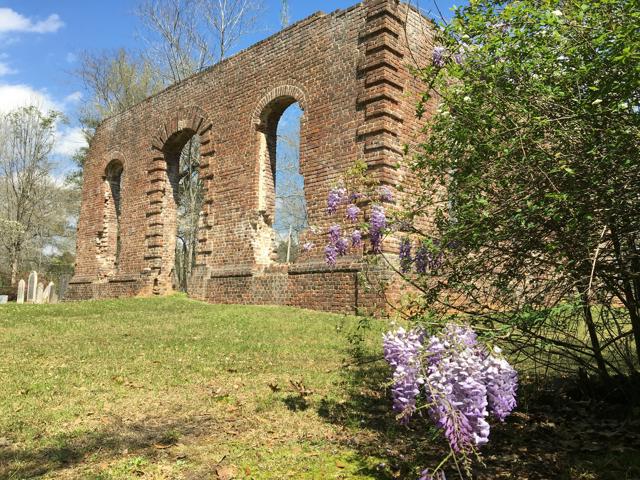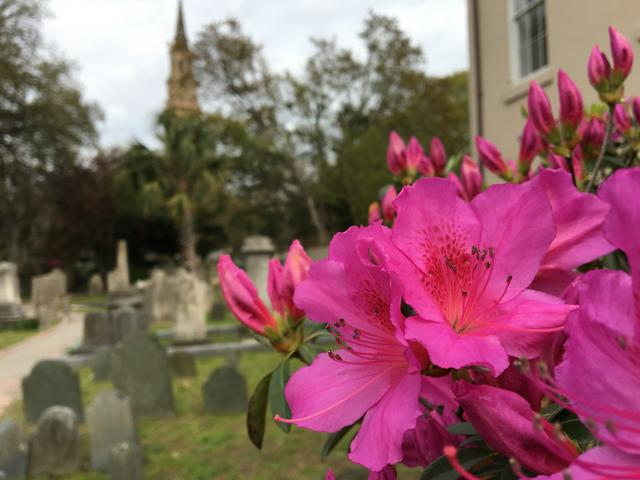Our Lowcountry adventure began with lunch in tiny Santee (a “one stoplight town” kind of place), and led us down meandering roads until we reached the Biggins Church ruins of Moncks Corner. Thought the ruins are hauntingly lovely at any time of year, this site becomes a natural garden in the spring. Surrounded by old oaks festooned in Spanish moss, azaleas in every shade of pink, and draped in wisteria, it’s a photographer’s dream. The church structure dates to 1761, and suffered three fires before reaching its present state of happy abandon.
Just down the road is Mepkin Abbey, with a rich history of its own. Once the plantation home of Henry Laurens, the estate was gifted to a group of Trappist monks in 1949 by Clare Boothe Luce and her husband, Henry Luce. Today, you can visit the abbey and lovely botanical gardens with beautiful views of the Cooper River. For history lovers (and avid Hamilton fans!) you can visit the graves of Henry Laurens and his son John.
Our next stop was a special visit to Pompion Hill Chapel – a 1763 chapel of ease that is now privately owned and has been beautifully preserved. Situated beside the Cooper River, the churchyard’s gravestones are weathered but still legible after centuries of close contact with the water, and provide a fascinating glimpse into early South Carolina life.
After our drive along the Cooper River, we crossed the Ravenel Bridge and arrived in Charleston. After a wine and cheese reception at our pink plastered hotel, the Meeting Street Inn, our group enjoyed a delicious dinner together at Anson’s Restaurant. We’re still thinking about that pecan pie…
Monday dawned pearly gray, with the promised rain holding off to a short shower. We began our day with a driving tour around downtown Charleston, which looped us around the Battery and up through the Citadel grounds…where we found ourselves briefly trapped on campus during a class change, as cadets kept up an endless file in front of our van. After we made our escape, our attention turned to learning more about Charleston’s previous inhabitants. We met Virginia Ellison, Director of Archives and Research, and her colleagues for a special tour of the South Carolina Historical Society’s archives. They treated us to a look at special items from their collection, including a lithograph of the South Carolina Ordinance of Secession, and a Union soldier’s Civil War letters. Following this thread of Civil War era history, we drove to James Island to see the community formerly – and rebelliously – named Secessionville, and uncovered the site where the first shots were fired on Fort Moultrie (now Sumter).
After a leisurely lunch, it was time to begin our touring of the Meeting Street homes with the Festival of Houses & Gardens. A few favorites were Two Meeting Street Inn, now a lovely bed and breakfast, and the Dependency of Brandford-Horry House – formerly a carriage house, now a stunning private home with an Italianate interior.
Tuesday morning saw us off to explore Johns Island and Wadmalaw Island. At the Charleston Tea Plantation, we enjoyed a trolley tour of the grounds, and even waved to the founder, Bill Hall, who was at work out in the fields. We sampled just about every type of tea imaginable, then visited the lovely, well-hidden village of Rockville and the iconic Angel Oak. After a tasty lunch at the Stono Market and Tomato Shed Cafe (the locals recommend the chocolate zucchini bread), it was time to head home. We’ll be back, Charleston.




